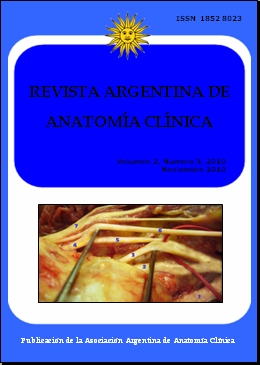VARIABILITIES IN ANATOMICAL ARRANGEMENT OF SACRAL PLEXUS ROOTS. VARIACIONES EN LA DISPOSICIÓN ANATÓMICA DE LAS RAÍCES DEL PLEXO SACRO
DOI:
https://doi.org/10.31051/1852.8023.v2.n3.13889Keywords:
plexo sacro, raíces, variaciones, sacral plexus, roots, variabilitiesAbstract
Introducción. Las ramas del plexo sacro juegan un rol importante en la inervación motora y sensitiva del miembro inferior. En operaciones de la médula espinal observamos diversas variedades y nos motivó para iniciar este estudio dirigido a determinar la formación del plexo sacro desde la emergencia de cada raíz en los agujeros sacros hasta la formación de sus ramas terminales. Material y método. Se examinaron 100 plexos sacros en 50 cadáveres adultos con el propósito de determinar incidencia de las variaciones nerviosas. También consideramos el recorrido de sus ramas, sus anastomosis y grosor. Destacamos las particularidades de la inervación motora en el diagnóstico, además de la complejidad y variaciones anatómicas. Resultados. En general observamos 3 raíces sacras con la participación de S4 y el tronco lumbo-sacro de L4 y L5, y 4 nervios sacros. Habitualmente se observó un recorrido ascendente doble de la raíz S1, mientras que para las otras raíces la emergencia doble no fue común. El tronco lumbosacro se engrosó en 19 casos. La división muy alta del nervio ciático (en la pelvis menor) se observó en 2 casos. El nivel de ramificación de los otros nervios dependió del tipo de plexo. Conclusión. Nuestro estudio reveló variaciones relativamente frecuentes y variaciones anatómicas extraordinarias en la formación de las raíces nerviosas y la ramificación del plexo sacro. El conocimiento detallado de estas variaciones es útil para el propio diagnóstico y el tratamiento quirúrgico de las lesiones del plexo sacro y el dolor idiopático.
Introduction. Branches of sacral plexus play an important role in the motor and sensory innervation of the lower limb. Various variations observed during the spinal operations have motivated us to start the study aimed on determination of the sacral plexus formation from its exit of particular roots from sacral foramina up to their formation into terminal branches. Material and method. One hundred sacral plexuses have been examined on 50 adult cadavers for a purpose to find out an incidence of its neural variations. We have considered also the course of their branches, the anatomoses and their thickness. We highlighted the motor innervation particularities in the relation to the diagnosis besides its anatomical complexity and variability. Results. Commonly were observed 3 sacral roots with the share of S4 and lumbosacral trunk of L4 and L5 and 4 sacral nerves. Doubled ascending course of S1 root was often observed, by the other sacral roots the doubled exit was not so frequent. Lumbosacral trunk was thickened in 19 cases. Very high division of the sciatic nerve (in the lesser pelvis) was observed in 2 cases. The branching off level of other nerves depended on the plexus type. Conclusion. Our study revealed a relatively frequent variabilities and described some extraordinary anatomical variations in the formation of nerve roots and branches of the sacral plexus. The detailed knowledge of these variabilities is useful for the proper diagnostics and surgical treatment of the sacral plexus injuries and unexplainable paient‘s complaints.
References
Bergman RA, Thompson SA, AWW AK, Saddeh FA. 1988. Compendium of human anatomical variations. Urban and Schwarzenburg, Baltimore, pp 138–139.
Erbil K, Onderoglu S, Basar R. 1998. Unusual branching in lumbar plexus. Case report. Folia Morphol (Warsz) 57: 377–381.
Chin Ch, Chew KC. 1997. Lumbosacral nerve root avulsion. Injury 28: 674–678.
Hope EE, Bodensteiner JB, Thong N. 1985. Neonatal lumbar plexus injury. Arch Neurol 42: 94–95.
Iczi Y, Gürkanlar D, Ozan H, Gönül E. 2005. The morphological aspects of lumbar plexus and roots. An anatomical study. Turk Neurosurg 15: 87–92.
Marieb EN, Mallat J. 2005. Základy embryologie, kapitola 3. In: Marieb EN Mallat J (eds) Anatomie lidského tela. Computer Press, a.s., Brno, pp 62–67.
O’Rahilly R, Muller F, Meyer DB. 1990. The human vertebral column at the end of the embryonic periods proper. 4. The sacrococcygeal region. J Anat 168: 95–111.
Urbanowitz Z. 1981. Connections between the lumbal and sacral plexus in man. Folia Morphol (Warsz) 40: 271–279.
Williams PL, Bannister LH, Berry MM, Collins P, Dyson M, Dussek JE, Fergusson MWJ. 1995. Gray’s anatomy, 38th edn. Churchill Livingstone, London, pp 1258–1274.
Williams PL, Warwick R. 1985. Gray’s anatomy, 36th edn. Churchill Livingstone, London, pp 1106–1110
Weber RH. 1961. Some variations in the lumbal plexus of nerves in man. Acta Anat 44:336–345.
Downloads
Published
Issue
Section
License
Authors retain copyright and grant the journal right of first publication with the work simultaneously licensed under a Creative Commons Attribution License that allows others to share the work with an acknowledgement of the work's authorship and initial publication in this journal. Use restricted to non commercial purposes.
Once the manuscript has been accepted for publications, authors will sign a Copyright Transfer Agreement to let the “Asociación Argentina de Anatomía Clínica” (Argentine Association of Clinical Anatomy) to edit, publish and disseminate the contribution.



